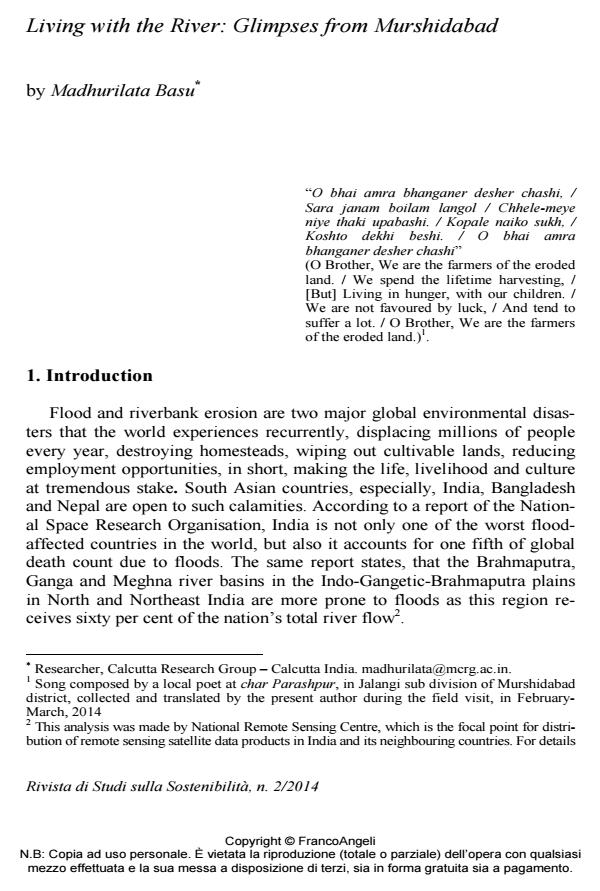Living with the River: Glimpses from Murshidabad
Titolo Rivista RIVISTA DI STUDI SULLA SOSTENIBILITA'
Autori/Curatori Madhurilata Basu
Anno di pubblicazione 2014 Fascicolo 2014/2 Lingua Inglese
Numero pagine 20 P. 105-124 Dimensione file 207 KB
DOI 10.3280/RISS2014-002007
Il DOI è il codice a barre della proprietà intellettuale: per saperne di più
clicca qui
Qui sotto puoi vedere in anteprima la prima pagina di questo articolo.
Se questo articolo ti interessa, lo puoi acquistare (e scaricare in formato pdf) seguendo le facili indicazioni per acquistare il download credit. Acquista Download Credits per scaricare questo Articolo in formato PDF

FrancoAngeli è membro della Publishers International Linking Association, Inc (PILA)associazione indipendente e non profit per facilitare (attraverso i servizi tecnologici implementati da CrossRef.org) l’accesso degli studiosi ai contenuti digitali nelle pubblicazioni professionali e scientifiche
In a district affected by poverty, flood, riverbank erosion, the life of people in the ‘borderlands’, in Murshidabad, is a story of everyday struggle and endless negotiations. Being a border district, Murshidabad, is under constant supervision of the security personnel. But the process of ‘othering’ becomes complete when one reaches river chars or charlands that also coincide with the Indo-Bangladesh border. Whims of the river, affecting the life and livelihood of the people, clubbed with various sorts of restrictions on movements, indifference of the local administration, difficulties in accessing various kinds of amenities like hospitals, schools or food items at subsidized rates, make them near-citizens. This paper explores the realities in two charlands in Jalangi- char Parashpur and char Bhadra.
In un distretto colpito da povertà, alluvioni, erosione delle sponde del fiume, la vita delle persone nelle terre di confine, in Murshidabad, è una storia di lotta quotidiana e di interminabili negoziati. Essendo un distretto di confine, Murshidabad, è sotto la costante supervisione del personale di sicurezza. Ma il processo di ‘othering’, di percezione dell’altro, diventa completo quando si raggiunge il fiume, le chars o charlands, che coincidono anche con il confine tra India e Bangladesh. I capricci del fiume, che influenzano la vita e il sostentamento delle persone, bastonate con vari tipi di restrizioni ai movimenti, indifferenza dell’amministrazione locale, difficoltà nell’accedere ai vari tipi di servizi come ospedali, scuole o prodotti alimentari a prezzi agevolati, li rendono cittadini a noi prossimi. Questo articolo esplora la realtà in due charlands del fiume Jalangi char Pareshpur e char Bhadra.
Keywords:Alluvioni, erosione della sponda del fiume, chars/charlands, confini, sicurezza alimentare, traffico illegale
- Basu P., Mukhopadhyay S., Jayaraman T. (2012). Climate Change Adaptation in Flood Plain of West Bengal. Climate Change Policy Paper, I: 1-15,at http://awsassets.wwfindia.org/downloads/climate_change_adaptation_in_flood _plains_of_west_bengal.pdf. Last accessed, 2 April 2014.
- Basu S.P., Dasgupta G. (eds.) (2011). Politics in Hunger-Regime. Frontpage, Kolkata.
- Lahiri-Dutt K., Samanta G. (2007). “Like the Drifting Grains of Sand”: Vulnerability, Security and Adjustment by Communitiesin the Charlands of the Damodar River, India’. South Asia: Journal of South Asian Studies. 30(2): 327-349, DOI: 10.1080/00856400701499268
- Government of India (2010). West Bengal Development Report. Planning Commision, New Delhi.
- Government of India (2011). Murshidabad: Census, at http://www.census2011.co.in/census/district/7-murshidabad.html. Last accessed 24 March 2014.
- Government of India (2013). Perceived Adequacy of Food Consumption in Indian Households. NSS 66th Round (July 2009-June 2010, National Statistical Organisation). Ministry of Statistics and Programme Implementation, New Delhi, at http://mospi.nic.in/mospi_new/upload/nss_report_547.pdf. Last accessed 5
- May, 2014. Government of West Bengal (2009). Livestock Population Handbook. Evaluation Wing, Directorate of Agriculture. Bureau of Applied Economics & Statistics, Kolkata.
- Government of West Bengal (2011). Annual Report 2010-2011. Irrigation and Waterways Department, Kolkata.
- Human Rights Law Network (2006). Trafficking and the Law. Human Rights Law Network, New Delhi.
- Mukherjee J. (2011). No Voice, No Choice: Riverine Changes and Human Vulnerability in the “Chars” of Malda and Murshidabad. Occasional Paper 28. IDSK, Kolkata.
- National Crime Records Bureau (2009). Human Trafficking, at ncrb.nic.in/CII%202009/cii-2009/Chapter%206star.pdf. Last accessed 23 March, 2014.
- O’Malley L.S.S (1874). Murshidabad, at http://archive.org/stream/murshidabadbylss00omaluoft/murshidabadbylss00omaluoft_djvu.txt. Last accessed
- 14 April 2014.
- Rudra K. (2012). The Encroaching Ganga and Social Conflicts: The Case of West Bengal, India, at http://gangapedia.iitk.ac.in/sites/default/files/Rudra.pdf. Last accessed 4 March, 2014.
- Sachar R. (2006). Social, Economic and Educational Status of the Muslim Community of India – A Report, Prime Minister’s High Level Committee, Cabinet Secretariat. Government of India, New Delhi.
- Sarkar E. (2013). Flow: River Legends from India. Typeshype, India. Van Schendel W. (2005). The Bengal Borderland: Beyond State and Nation in South Asia. Anthem Press, London.
Madhurilata Basu, Living with the River: Glimpses from Murshidabad in "RIVISTA DI STUDI SULLA SOSTENIBILITA'" 2/2014, pp 105-124, DOI: 10.3280/RISS2014-002007